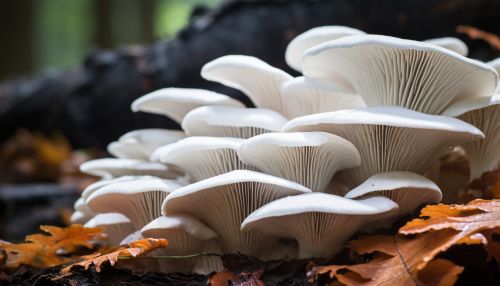Pleurotus ostreatus
Introduction
Pleurotus ostreatus, commonly known as the oyster mushroom, is a species of fungus that belongs to the family Pleurotaceae. This mushroom is named for its oyster-like shape and is one of the most commonly cultivated edible mushrooms worldwide.


Taxonomy and Naming
The species was first described scientifically by the German naturalist Jacob Christian Schäffer in 1774. The genus name Pleurotus comes from the Greek words pleuron, meaning "side", and otus, meaning "ear", referring to the mushroom's characteristic ear-like shape. The species name ostreatus is derived from the Latin word ostreum, meaning "oyster", again referring to the mushroom's shape.
Description
Pleurotus ostreatus has a broad, fan or oyster-shaped cap spanning 5–25 cm; natural specimens range from white to gray or tan to dark-brown. The margin is inrolled when young, and is smooth and often somewhat lobed or wavy. The flesh is white, firm, and varies in thickness due to stipe arrangement. The gills of the mushroom run down its short, off-center stipe, which tapers down seamlessly from the cap. It has a sweet smell and a mild, pleasant taste.
Distribution and Habitat
Pleurotus ostreatus is a saprophytic species, meaning it feeds on dead organic matter, particularly hardwoods. It is found throughout the Northern Hemisphere, particularly in temperate and subtropical forests. It grows in clusters on the trunks of dead or dying trees, particularly deciduous trees such as beech, oak, and birch. The species has also been found growing on conifer wood.
Cultivation
The cultivation of Pleurotus ostreatus began in Germany as a subsistence measure during World War I and is now grown commercially around the world for food. It is one of the most important and widely cultivated mushrooms worldwide, with China being the largest producer. The mushroom is grown on a substrate of sterilized cereal straw and is known for its robustness and adaptability, making it a popular choice for novice mushroom cultivators.
Culinary Uses
Pleurotus ostreatus is highly prized as a culinary mushroom, due to its robust flavor and texture. It has a subtle, savory anise flavor and a meaty texture, making it a popular vegetarian substitute for meat. It is used in a variety of dishes, including stir-fries, soups, and stews, and can be sautéed, grilled, or roasted.
Medicinal Uses
In addition to its culinary uses, Pleurotus ostreatus has been used in traditional medicine for its purported health benefits. It is rich in proteins, vitamins, and minerals, and low in fat and cholesterol. It has been studied for its potential to lower cholesterol levels, boost the immune system, and fight cancer cells.
See Also
Categories
References
1. Stamets, P. (2000). Growing Gourmet and Medicinal Mushrooms. Ten Speed Press. 2. Chang, S. T., & Miles, P. G. (2004). Mushrooms: Cultivation, Nutritional Value, Medicinal Effect, and Environmental Impact. CRC Press. 3. Smith, A. H., & Weber, N. S. (1980). The Mushroom Hunter's Field Guide. University of Michigan Press.
